How to Select the Right OKR Software
The Ultimate Guide to help you select and implement the right OKR Software
Manual tracking of OKRs can be inefficient and prone to errors. This is where OKR software comes into play, offering tools that facilitate the easy setting, tracking, and analyzing of objectives and their corresponding key results. Choosing the right OKR software is crucial because it significantly affects the effectiveness of the OKR implementation.
Good OKR software should seamlessly integrate with an organization’s workflow, ensuring that the process of managing OKRs is as intuitive and least disruptive as possible. It should empower teams to perform their best, not just by tracking goals but by offering insights and analytics that guide strategic decisions. Moreover, the right tool should cater to the specific needs of your organization, considering factors like company size, industry, and existing software ecosystem.
Selecting the appropriate OKR software is not just about buying a tool; it’s about investing in a solution that will enhance your organization’s ability to execute its strategy, adapt to change, and ultimately achieve its long-term objectives. Therefore, it’s imperative to approach this choice with thorough understanding and careful consideration.
Key Features to Look for in OKR Software
1. Goal-Setting Functionalities
OKR software should offer robust goal-setting features that allow users to easily set, revise, and align objectives across different levels of the organization—from individual contributors to top management. It should support the establishment of both qualitative objectives and quantitative key results. Look for features that enable cascading goals, which ensure alignment and visibility throughout the organization.
2. Tracking Progress and Analytics
Effective OKR software provides comprehensive tracking capabilities that help you monitor progress towards each key result. Analytics play a crucial role here, offering insights into performance trends, goal completion rates, and areas needing attention. Advanced software may include predictive analytics to forecast future performance and suggest corrective actions.
3. Integration Capabilities with Other Tools
To streamline operations and maintain productivity, your OKR software should integrate seamlessly with other tools used by your organization. This includes project management software, CRM systems, ERP solutions, and various workflow tools. Effective integration ensures that data flows smoothly across platforms, reducing the need for manual data entry and minimizing the associated risk of errors.
-
Project Management and Workflow Software
Integration with project management and workflow tools like Jira, Asana, Trello, and Monday.com is crucial. These platforms are often where the day-to-day operational tasks are managed, and connecting them with your OKR software ensures that progress on tasks can be directly linked to strategic objectives and key results. This connection provides real-time updates and insights into how daily activities influence long-term goals.
-
CRM and ERP Systems
Linking OKR software with CRM (Customer Relationship Management) systems like Salesforce, HubSpot, or Dynamics 365 allows sales and marketing objectives to be directly correlated with customer data, enhancing the accuracy of sales forecasts and marketing strategies. Similarly, integrating with ERP (Enterprise Resource Planning) systems such as SAP, Oracle, or NetSuite can help align financial and operational metrics with company objectives, providing a holistic view of organizational performance.
-
APIs for Custom Integrations
Look for OKR software that offers robust API (Application Programming Interface) support, which is essential for creating custom integrations. APIs allow your IT team to develop bespoke connections that can link the OKR software with other niche or legacy systems within your organization. This flexibility is particularly important for large enterprises or companies with specialized software needs.
-
Collaboration and Communication Tools
Integrations with collaboration and communication tools like Slack, Microsoft Teams, or Google Workspace ensure that updates and notifications about OKRs are disseminated quickly and effectively across the organization. This fosters a culture of transparency and continuous feedback, which is vital for the successful adoption of OKRs.
4. User Interface and Usability
The user interface and usability of OKR software are critical for ensuring widespread adoption and effective use within your organization. A well-designed interface should be intuitive, making it easy for all users, regardless of their tech-savviness, to engage with the software effectively.
-
Simplicity
The interface should be clean and uncluttered, avoiding excessive menus or complicated navigation paths. For example, Weekdone uses a straightforward dashboard that presents weekly plans, objectives, and key results at a glance, enabling quick updates and reviews without navigating away from the main screen.
-
Visual Clarity
Use of colors and icons should be purposeful and consistent. Perdoo offers a visually clear interface where different colors represent the status of objectives (e.g., on track, off track, at risk), and icons are used to indicate actions like editing or updating key results, making it easy to see the status of objectives at a quick glance.
-
Interactive Elements
Interactive elements such as drag-and-drop for reordering objectives, clickable progress bars, or hover-over effects for more information can enhance the user experience. Ally.io, for instance, incorporates interactive goal trees that visually map how individual objectives connect to broader company goals, allowing users to understand dependencies and alignments with simple interactions.
-
Responsive Design
The software should be usable across various devices and screen sizes, from desktops to tablets and smartphones. Betterworks ensures that its platform is fully responsive, allowing users to update their progress or check their objectives on any device, which is crucial for teams that are on the move or work remotely.
-
Accessibility
Ensuring that the software is accessible to users with disabilities is also essential. This includes providing keyboard navigation, screen reader support, and options to change text size or contrast. Lattice incorporates accessibility features that help users with different needs navigate through the application, promoting inclusivity.
-
Tooltips and Help
Integrating tooltips and on-demand help resources within the interface can aid users who need assistance. These features offer instant access to support without the need to exit the workflow to look up help documentation. For example, 7Geese includes intuitive tooltips and inline help guides that offer contextual help, reducing the learning curve and supporting user self-sufficiency.
5. Customization Options
Each organization has unique needs and processes. The OKR software you choose should offer customization options that allow you to tailor functionalities to match your specific requirements. This can include custom dashboards, flexible reporting formats, and the ability to modify key result metrics to fit different departmental goals.
6. Mobile Access and Cloud-Based Services
Having access to OKR software on the go is essential. Mobile apps enhance accessibility and convenience, enabling team members to update progress and check objectives from anywhere. Additionally, cloud-based OKR software offers advantages in scalability, security, and maintenance, as updates and backups are managed by the service provider.
Technical Considerations
1. Security Features and Data Protection
Security is paramount in any software solution, particularly when sensitive organizational goals and performance data are involved. OKR software should offer robust security features such as:
- Encryption: Data both in transit and at rest should be encrypted using strong encryption protocols like TLS for data in transit and AES for data at rest.
- Authentication and Authorization: Implementations of multi-factor authentication (MFA) and role-based access controls ensure that only authorized personnel have access to specific levels of data.
- Regular Security Audits: The provider should conduct regular security audits and penetration testing to identify and mitigate potential security vulnerabilities.
2. Scalability and Performance Under Load
Scalability is critical to ensure that the software can handle growth in user numbers and data volume without degradation in performance:
- Cloud-based Architecture: Many modern OKR software solutions are cloud-based, which naturally allows for better scalability and flexibility.
- Load Balancing: Techniques such as load balancing distribute traffic and actions on the software across multiple servers, preventing any single server from becoming a bottleneck.
3. Data Backup and Recovery Processes
Reliable data backup and recovery processes are crucial to prevent data loss and ensure continuity in case of an outage or other disruptions:
- Automatic Backups: The software should automatically back up data at regular intervals to secure storage.
- Recovery Procedures: There should be clear, tested procedures for data recovery that can be initiated immediately after data loss is detected.
4. Compliance with Industry Standards and Regulations
Compliance ensures that the software meets industry-specific standards and regulations, which may include GDPR for data protection in Europe, HIPAA for health information in the U.S., or SOC 2 compliance for general security practices:
- Regular Compliance Audits: The software provider should undergo regular audits to ensure continuous compliance with these standards.
- Data Sovereignty: The ability to store data in specific geographical locations can be crucial for compliance with national data protection laws.
Evaluating OKR Software Providers
1. Market Reputation and Reliability
- User Reviews and Testimonials: Look for reviews on third-party platforms like Capterra, G2, or TrustRadius to get unbiased insights into user experiences with the software.
- Industry Recognition: Check for awards, recognitions, or certifications from reputable industry bodies which can indicate the provider’s commitment to quality and innovation.
- Clientele and Case Studies: Review case studies or success stories provided by the vendor that showcase real-world applications and benefits of the software.
2. Customer Support and Training Resources
- Availability of Support: Good customer support should be accessible via multiple channels (phone, email, live chat) and available 24/7, especially if the provider serves customers globally.
- Training Resources: Comprehensive training resources such as video tutorials, webinars, and detailed documentation can facilitate smoother onboarding and ongoing usage of the software.
- Community and Forums: Some providers offer access to user communities or forums where customers can exchange tips, solutions, and best practices.
3. Pricing Models and Cost-Effectiveness
- Subscription vs. One-Time Fee: Most OKR software is available on a subscription basis, which can vary based on features, the number of users, and the level of support. Evaluate whether the pricing model aligns with your budget and business model.
- Scalability of Pricing: Consider whether the pricing model is scalable. As your organization grows, the cost should remain predictable and affordable.
- Hidden Costs: Be wary of hidden costs such as setup fees, additional charges for integrations, or costs associated with data migration.
4. Free Trials and Demos Availability
- Trial Period: A free trial period allows your team to test the software’s functionality and its fit with your company’s workflows without any financial commitment.
- Live Demos: Request live demos to see the software in action and to ask real-time questions about its capabilities and limitations.
- Custom Demo Based on Use Case: Some vendors can provide a demo tailored to your specific business needs, which can help you better understand how the software can solve your particular challenges.
Questions to Ask When Selecting OKR Software
Asking the right questions during the selection process is crucial to finding OKR software that best fits your organizational needs. Here are several important questions to ask, along with suggested answers you might look for from a provider:
-
What kind of customer support do you offer?
Suggested Answer: Look for providers that offer comprehensive support through multiple channels (email, phone, chat), with 24/7 availability or business hours that match your time zone. Good support should also include access to a dedicated account manager and a responsive technical support team.
-
How does the software handle data privacy and security?
Suggested Answer: The provider should offer strong encryption for data at rest and in transit, perform regular security audits, and have clear data privacy policies compliant with global standards like GDPR or HIPAA.
-
Can the software integrate with our existing tools?
Suggested Answer: The ideal software should provide built-in integrations with popular tools such as Slack, Microsoft Teams, Salesforce, and various project management tools like Jira and Asana. It should also support custom integration capabilities through an accessible API.
-
What are the customization options?
Suggested Answer: The software should allow you to customize workflows, dashboards, and reports to fit your specific business needs. Look for options to define custom roles, permissions, and to tailor features to support your company’s OKR methodology.
-
How do you manage software updates and scalability?
Suggested Answer: The provider should have a clear roadmap for software updates, including regular updates that introduce new features and improvements without disrupting existing setups. Scalability should be handled smoothly, with the platform capable of supporting growth in user numbers and data volume without performance lags.
-
What training resources do you provide to ensure successful adoption?
Suggested Answer: Effective providers will offer comprehensive training materials, including webinars, live training sessions, and a knowledge base with articles and tutorials. They may also provide onboarding assistance to help integrate the platform into your processes.
-
How do you ensure the software remains aligned with the latest OKR trends and methodologies?
Suggested Answer: Look for providers who actively engage with thought leaders in the OKR community, regularly update their features to reflect best practices, and who contribute to ongoing research and discussions in the field.
-
What reporting and analytics capabilities does the software include?
Suggested Answer: The software should offer robust analytics tools that provide insights into OKR progress, including customizable reports, real-time dashboards, and the ability to track historical trends to assess performance over time.
-
Can we export data for external analysis?
Suggested Answer: The ability to export data into common formats (like CSV or Excel) for further analysis or for use in other systems is essential, particularly for larger organizations that rely on comprehensive data analysis.
-
How is goal alignment handled within the software?
Suggested Answer: The software should allow for easy alignment of individual OKRs with team and company goals, possibly through visual mapping or automated alignment features that highlight dependencies and contributions across the organization.
-
What mobile capabilities does the software have?
Suggested Answer: Given the increasing reliance on mobile devices, the software should have a robust mobile app or a mobile-responsive design that allows users to access, update, and monitor their OKRs on the go.
-
What kind of notification system does the software employ?
Suggested Answer: Effective OKR software should include customizable notifications for key activities like updates to key results, approaching deadlines, or changes in goal alignment, helping keep everyone informed and proactive.
-
How customizable is the feedback and review process within the software?
Suggested Answer: The platform should offer flexible options for scheduling, conducting, and recording feedback related to OKRs, including 360-degree feedback, continuous feedback loops, and integration with performance review processes.
-
Can the software handle multiple time zones for globally dispersed teams?
Suggested Answer: For organizations with a global presence, the software should be capable of supporting users across multiple time zones, displaying deadlines and updates according to each user’s local time.
-
Does the software offer language localization?
Suggested Answer: If your workforce is diverse and multilingual, check if the software provides localization options to cater to various languages, enhancing usability and accessibility for all users.
Implementing OKR Software
1. Steps to Effectively Implement OKR Software
-
Pre-Implementation Planning
Before you introduce the software, define your objectives clearly and determine how OKRs will align with your strategic goals. Involve key stakeholders in this phase to ensure the software meets the needs of all parts of your organization.
-
Choose a Champion
Designate an OKR champion within your organization who will lead the implementation process, act as a point of contact for the vendor, and address any internal questions or issues.
-
Customize the Tool to Fit Your Needs
Work with the software provider to configure the tool according to your organizational structure, workflows, and reporting needs. This might include setting up integrations with existing tools and customizing dashboards and reports.
-
Pilot Testing
Conduct a pilot test with a small group before a full rollout. This approach allows you to gather feedback and make necessary adjustments to the training and implementation process.
-
Rollout to the Entire Organization
Once the pilot is successful, gradually roll out the software across the organization. Use phased deployment if your organization is large to manage the transition smoothly.
2. Training Your Team to Use the Software
- Initial Training Sessions: Organize comprehensive training sessions that cover how to use the software effectively. These should be tailored to different user groups within your organization (e.g., executives, managers, individual contributors).
- Ongoing Support and Learning: Provide ongoing training opportunities, such as refresher courses, advanced training for power users, and Q&A sessions to address specific issues.
- Documentation and Resources: Make sure that detailed user guides, FAQs, and online resources are readily available to help team members learn at their own pace.
3. Monitoring and Adjusting as You Go
- Regular Check-Ins: Schedule regular check-ins to review the use of the OKR software and gather feedback from users across the organization.
- Performance Analytics: Utilize the software’s analytics tools to monitor engagement and the achievement of key results, identifying areas where the software is being used effectively and where improvements are needed.
- Iterative Improvements: Based on feedback and performance data, make iterative improvements to both your OKR processes and how you use the software. This might involve adjusting goal-setting protocols, updating integration points, or changing configuration settings.
Final Word
In conclusion, selecting and implementing the right OKR software is pivotal to ensuring the success of your organization’s OKR initiatives. The right tool not only streamlines goal setting and tracking but also enhances strategic alignment, fosters collaboration, and provides valuable insights through advanced analytics. By carefully evaluating features, technical considerations, and provider reputation, and by ensuring thorough implementation and training, you can significantly boost your organization’s ability to execute its strategy effectively. Ultimately, the chosen software should empower your teams to achieve their objectives efficiently and adapt to the evolving demands of the business environmen





